Coronavirus (COVID-19): modelling the epidemic (issue no. 30)
Latest findings in modelling the COVID-19 epidemic in Scotland, both in terms of the spread of the disease through the population (epidemiological modelling) and of the demands it will place on the system, for example in terms of health care requirement
This document is part of a collection
Coronavirus (COVID-19): modelling the epidemic in Scotland (Issue No. 30)
Background
This is a report on the Scottish Government modelling of the spread and level of Covid-19. This updates the previous publication on modelling of Covid-19 in Scotland published on 03 December 2020. The estimates in this document help the Scottish Government, the health service and the wider public sector plan and put in place what is needed to keep us safe and treat people who have the virus.
This edition of the research findings focuses on the epidemic as a whole, looking at estimates of R, growth rate and incidence as well as local measures of change in the epidemic.
Key Points
- The reproduction rate R in Scotland is currently estimated as being between 0.7 and 0.9.
- The number of new daily infections for Scotland is estimated as being between 39 and 76, per 100,000 people.
- The growth rate for Scotland is estimated as being between - 5% and - 2%.
- The proportion of people testing positive aged 65 or over increased by just over 5% since the beginning of September to reach 15% in the first week of December.
- Average contacts per day are approximately three quarters higher than the level at the beginning of the stay-at-home advice, and less than half of the level pre-stay-at-home advice. The number of contacts has remained at a consistent level in the last two weeks.
- Modelled rates per 100K indicate that by the week of 20 - 26 December, 12 (down 4 from last week) local authorities have at least a 75% probability of exceeding 50 cases, 2 (down 2) of those have at least a 75% probability of exceeding 100 cases, 1 (up 1) of those has at least a 75% probability of exceeding 300 cases and none of those have at least a 75% probability of exceeding 500 cases. Overall, this is a slight improvement compared to last week.
Overview of Scottish Government Modelling
Epidemiology is the study of how diseases spread within populations. One way we do this is using our best understanding of the way the infection is passed on and how it affects people who catch it to create mathematical simulations. Because people who catch Covid-19 have a relatively long period in which they can pass it on to others before they begin to have symptoms, and the majority of people infected with the virus will experience mild symptoms, this "epidemiological modelling" provides insights into the epidemic that cannot easily be measured through testing e.g. of those with symptoms, as it estimates the total number of new daily infections and infectious people, including those who are asymptomatic or have mild symptoms.
Modelling also allows us to make short-term forecasts of what may happen with a degree of uncertainty. These can be used in health care and other planning. The modelling in this research findings is undertaken using different types of data which going forward aims to both model the progress of the epidemic in Scotland and provide early indications of where any changes are taking place.
Modelling outputs are provided here on the current epidemic in Scotland as a whole, based on a range of methods. Because it takes a little over three weeks on average for a person who catches Covid-19 to show symptoms, become sick, and either die or recover, there is a time lag in what our model can tell us about any re-emergence of the epidemic and where in Scotland this might occur. However modelling of Covid deaths is an important measure of where Scotland lies in its epidemic as a whole. In addition, the modelling groups which feed into the SAGE consensus use a range of other data along with deaths in their estimates of R and the growth rate. These outputs are provided in the first part of this research findings. The type of data used in each model to estimate R is highlighted in Figure 1.
A short term forecast and projection of the number of cases, ICU and hospital bed demand is also provided at this stage of the epidemic in Scotland.
Analysis of the pattern of demographics and clinical risk groups over time for those people who tested positive and hospital admissions has also been included.
A new tranche of results are provided from the Scottish Contact Survey (SCS), to indicate how people's contacts are changing.
What the modelling tells us about the epidemic as a whole
The various groups which report to the Scientific Pandemic Influenza Group on Modelling (SPI-M) use different sources of data in their models (i.e. deaths, hospital admissions, cases) so their estimates of R are also based on these different methods. SAGE's consensus view across these methods, as of 09 December, was that the value of Rt in Scotland was between 0.7 and 0.9. The R value estimated by the Scottish Government is very slightly higher than the consensus range (Figure 1).
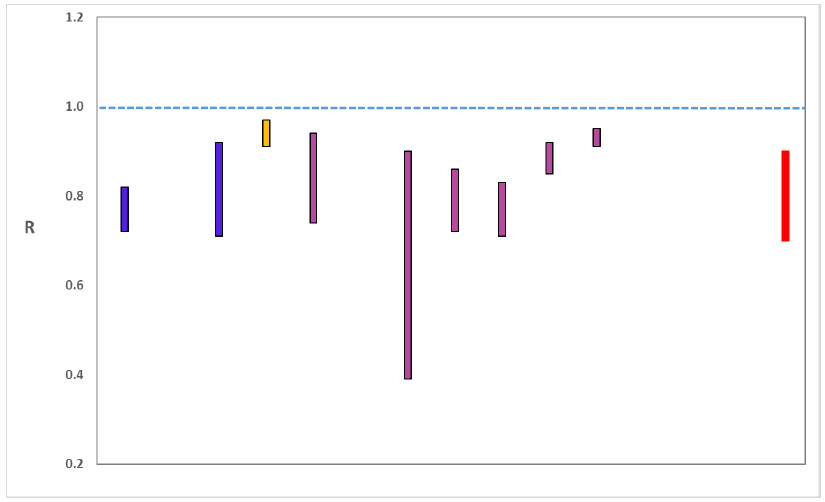
Source: Scientific Advisory Group for Emergencies (SAGE).
The various groups which report to the Scientific Pandemic Influenza Group on Modelling (SPI-M) use different sources of data in their models to produce estimates of incidence (Figure 2). SPI-M's consensus view across these methods, as of 09 December, was that the incidence of new daily infections in Scotland was between 39 and 76 new infections per 100,000. This equates to between 2,100 and 4,200 people becoming infected each day in Scotland.
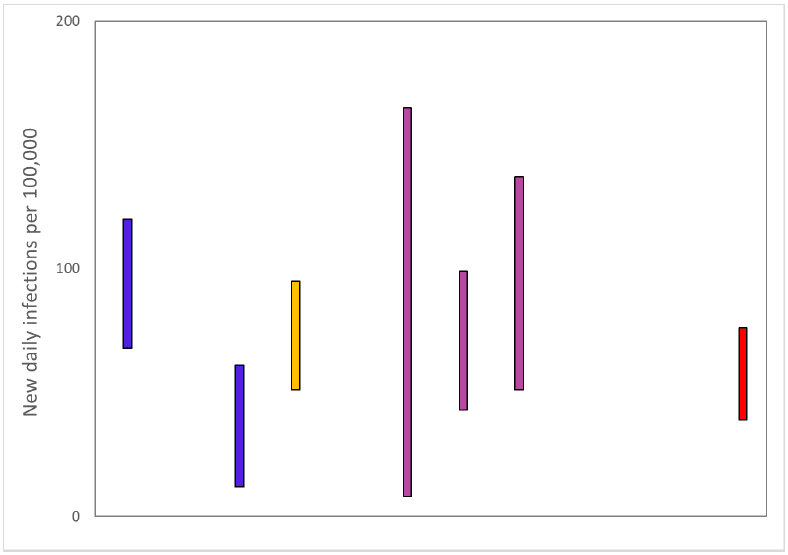
Source: Scientific Pandemic Influenza Group on Modelling (SPI-M).
The consensus from SAGE for this week is that the growth rate in Scotland is between -5% and -2% per day. Last week the growth rate was in the range -3% and -1%.
The logistical model developed by Scottish Government to assess implications for health care demand (see previous Research Findings) has been adapted to produce a short/medium-term prediction of infections.
Figure 3 shows a projection that assumes the Rt value is currently below the historical trend due to the introduction of Level 4 measures in parts of Scotland from 20 November.
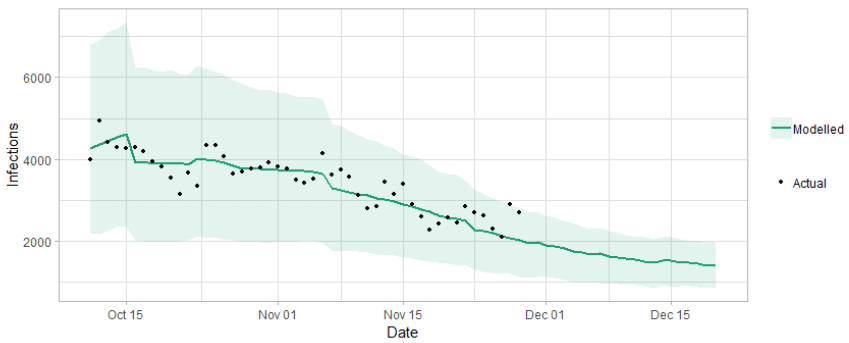
What the modelling tells us about Hospital bed and ICU bed demand
Figure 4 shows the impact of the projection on the number of people in hospital.
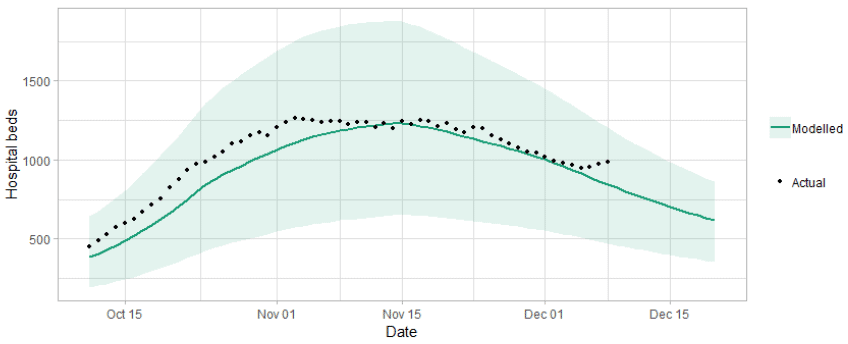
Figure 5 shows the impact of the projection on ICU bed demand.
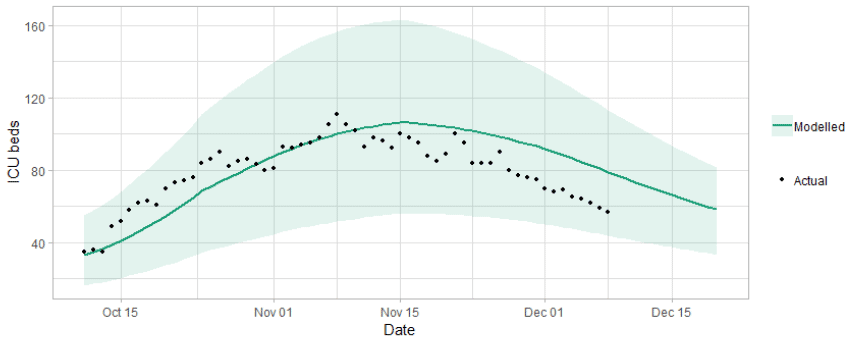
What the modelling tells us about projections of hospitalisations in the medium term
SAGE produce projections of the epidemic[1] (Figure 6), combining estimates from several independent models (including the Scottish Government Government's logistics modelling, as shown in figures 3, 4 and 5). These projections are not forecasts or predictions. They represent a scenario in which the trajectory of the epidemic continues to follow current trends and do not account for the impact of future policy or behaviour changes. Nor do they include seasonal effects that might increase transmission.
The delay between infection, developing symptoms, hospitalisation and death means the projections cannot fully reflect changes in transmission that might have occurred over the past two to three weeks.
Beyond two weeks, the projections become more uncertain with greater variability between individual models. This reflects the large differences that can result from fitting models to different data streams, and the influence of small deviations in estimated growth rates and current incidence.
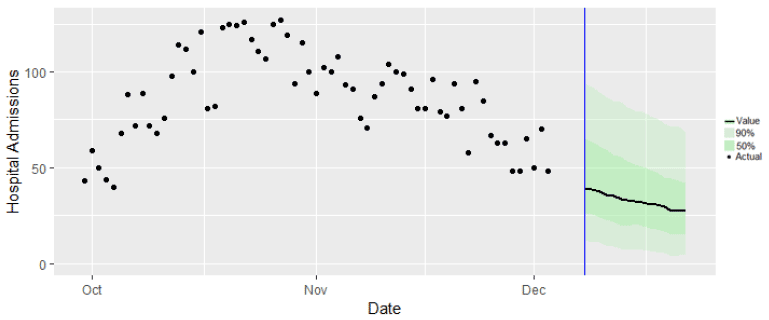
What we know about who is testing positive with Covid
The Early Pandemic Evaluation and Enhanced Surveillance of COVID-19 (EAVE) 2 Study Group[2] have updated the pattern of demographics and clinical risk groups over time for those who tested positive.
This second wave of the epidemic has been characterised by younger people testing positive, this peaked at the beginning of September and has reduced a little since then to around 35% at the end of November. The number of people who are testing positive who are older has increased slightly by just over 5% since the beginning of September and, by the first week in December, 15% of people now testing positive are 65 or over, see Figure 7.
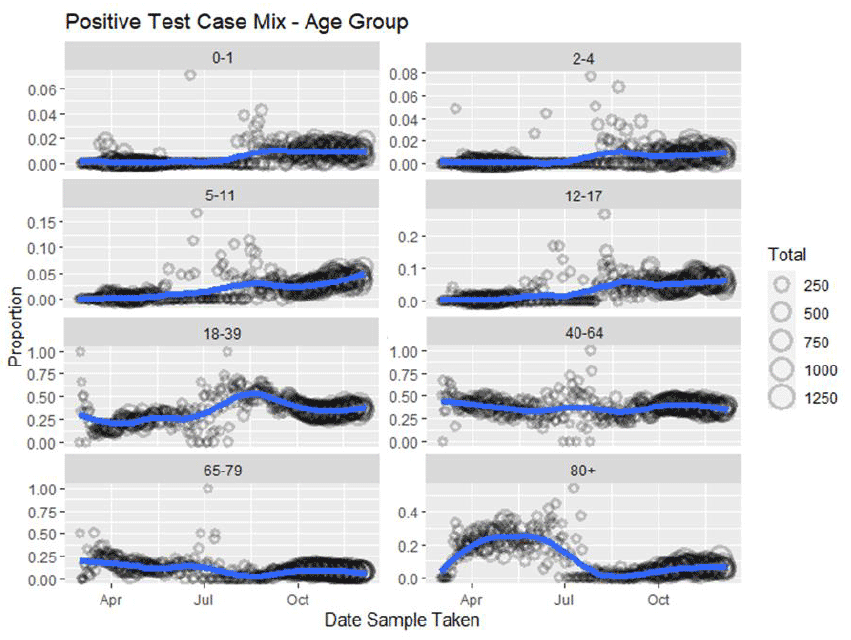
At the end of August, about 70% of those testing positive were categorised as not being in a clinical risk group, decreasing in September to about 60%, in early November to about 50% and rising to about 55% in late November. From August to late October there were increases in the proportions testing positive with three or more risk groups to 13% (has remained constant since then).
What we know about how people's contact patterns have changed
The average number of contacts per day are approximately three quarters higher than they were at the beginning of the Stay-at-home-advice, and less than half the level pre-Stay-at-home-advice (UK comparison 10.8).
Noticeable increases in mean contacts have been observed when schools return after term breaks. Following the end of half term, ending between 16 - 27 October, mean contacts increased by 11% from 2 weeks prior for Panel A. This increase is reflected in panel B where mean contacts have increased by 14% for the week beginning 05 November.
Since the introduction of protection levels, mean contacts have reduced by 12% from the week beginning 05 November to the week beginning 19 November as shown in Figure 8 for Panel B. In the prior week a similar decrease is also seen in Panel A (6%) but this has plateaued for the most recent survey (26 November - 02 December).
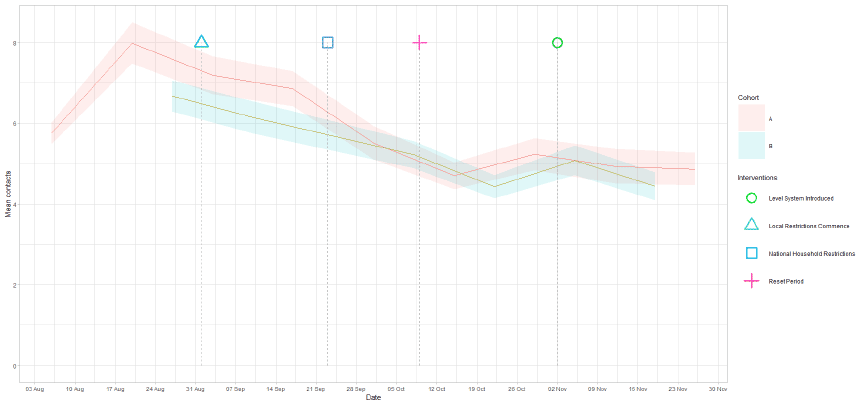
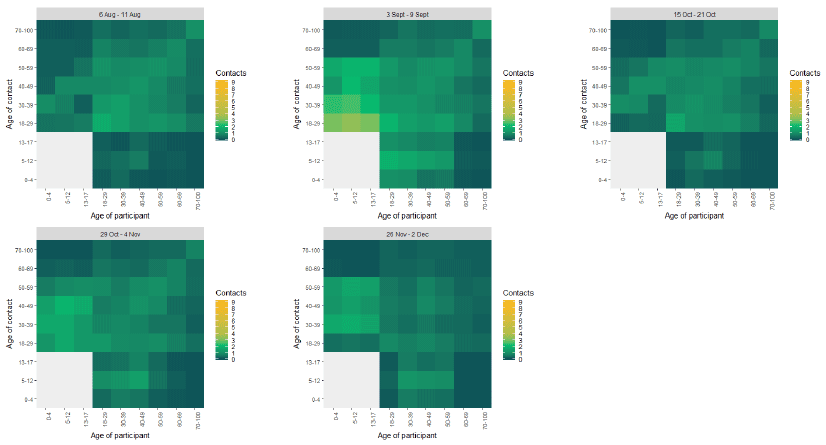
The heatmaps in Figure 9 show mean contacts by age group over time, from the start of August to the start of December. This illustrates that at the end of the half term period (16 - 27 October) there was an increase in mean contacts within the younger age groups which is likely due to individuals returning to work and school.
What we know about which regions are experiencing high levels of Covid
We use modelling based on Covid cases and deaths,[3] conducted by Imperial College London, to give us an indication of whether a local authority is experiencing high levels of Covid. An area is defined as a hotspot if the two week prediction of cases (positive tests) per 100K population are predicted to exceed a threshold, e.g. 500 cases. See technical annex in issue 24.
Modelled rates per 100K (Figure 10) indicate that by the week of 20 - 26 December, 12 (down 4 in the last week) local authorities have at least a 75% probability of exceeding 50 cases, 2 (down 2) of those have at least a 75% probability of exceeding 100 cases, 1[4] (up 1) of those has at least a 75% probability of exceeding 300 cases and none have at least a 75% probability of exceeding 500 cases.
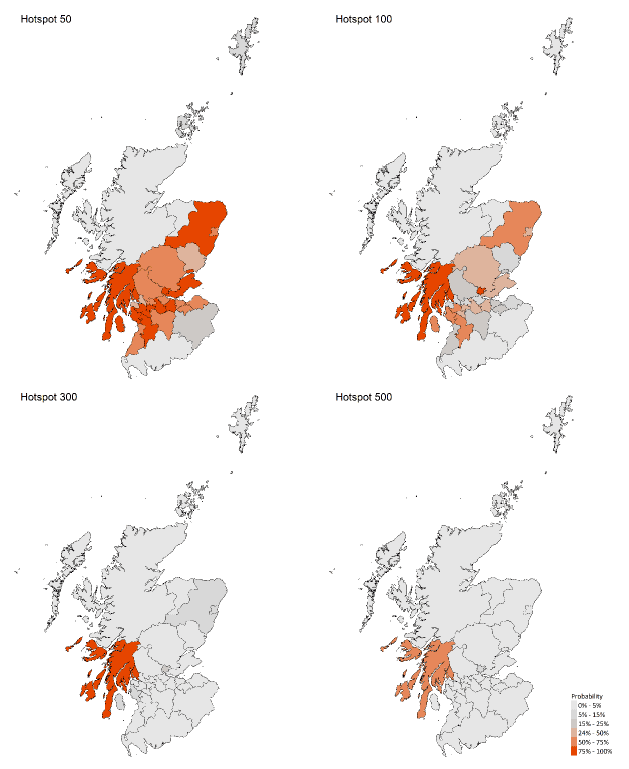
What next?
The Scottish Government continues to work with a number of academic modelling groups to develop other estimates of the epidemic in Scotland.
The modelled estimates of the numbers of new cases and infectious people will continue to be provided as measures of the epidemic as a whole, along with measures of the current point in the epidemic such as exceedance. Rt and growth rate will also be provided. Further information can be found at Coronavirus in Scotland.
We continue to track the analysis by SEPA (published last week) of the reported levels of Covid-19 in wastewater samples. We will report on this when there are new findings.
Contact
There is a problem
Thanks for your feedback